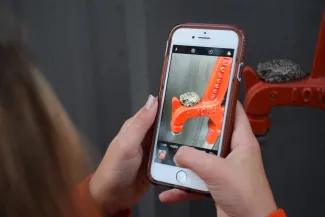Contributing to conservation can be as simple as sharing the details of wildlife sightings made in your backyard, during your commute, or on your recent hunting or fishing trip. Specific what, when, and where details of your sightings can help biologists track the status of fish, wildlife, and plants across the state.

What to Share
Sighting details can be shared for any organism, whether it’s common or rare, native, or introduced. Regardless of the species, knowing when and where it was spotted and how many were seen can help biologists plan for future conservation efforts. Photos and information about any markings or identification bands can strengthen the observation.
While documenting common plants and animals is as important as documenting rare species, naturalists can be on the lookout for sensitive species that are the focus of ongoing Wildlife Department projects. Wildlife sightings of bumble bees, Texas horned lizards, eastern whip-poor-wills, and loggerhead shrikes are of special interest.
How to Share
Once you’ve made your observation, photos and details about sighting can be shared at wildlifedepartment.com, or on free nature apps like iNaturalist or eBird. (iNaturalist collects observation details for all organisms while eBird focuses on bird sightings.)
Joining iNaturalist or eBird not only gives you a place to log and share your nature observations but also connects you with other naturalists in your area and helps you find new places to explore. Both apps allow you to search the respective databases for species and places of interest while also allowing observers to obscure the location of their sightings. iNaturalist can also offer identification suggestions when photos or sounds are uploaded and allows the larger iNaturalist community to suggest an identification after the sighting is posted.
When to Share
Wildlife sightings can be shared as soon as you make the observation, or whenever you chose to upload the details. Nature apps make it exceptionally easy to share information and photos within minutes of an observation, but some naturalists wait to share details of sensitive species so the individuals won’t be unintentionally harassed. If you won’t be sharing details the day of the sighting, consider jotting the specific date and location along with any notes that will help jog your memory.